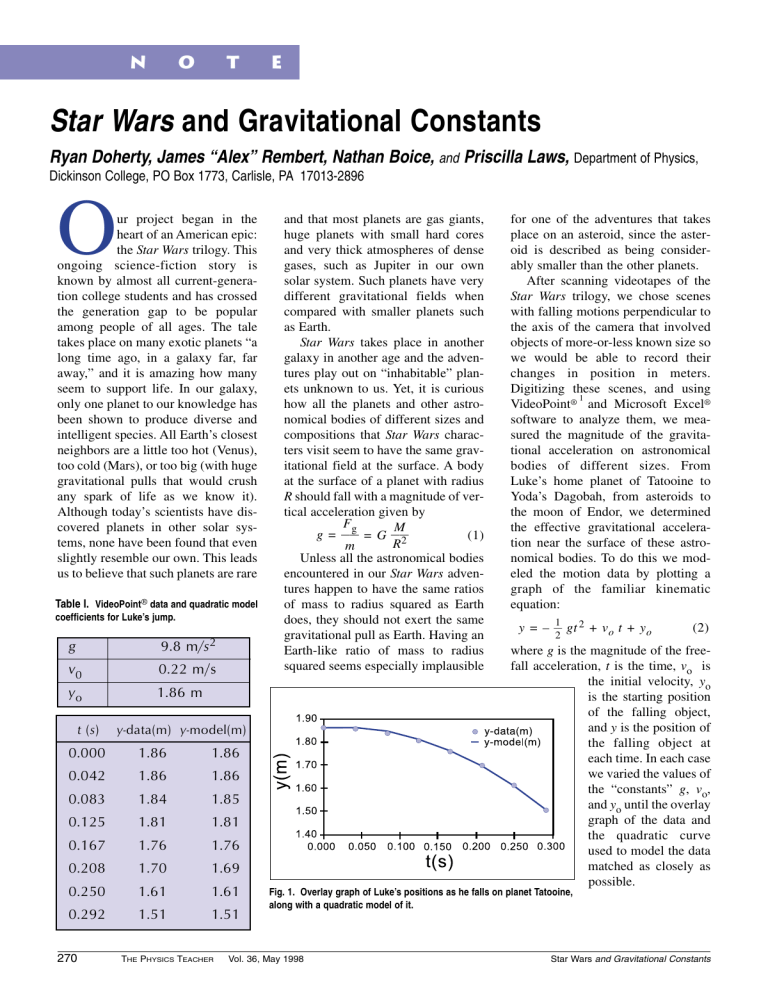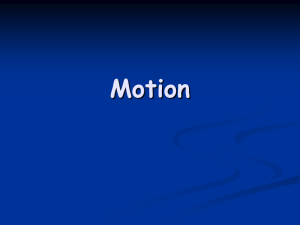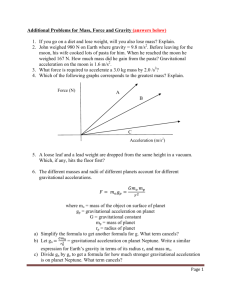Star Wars and Gravitational Constants
advertisement

N o t e Star Wars and Gravitational Constants Ryan Doherty, James “Alex” Rembert, Nathan Boice, and Priscilla Laws, Department of Physics, Dickinson College, PO Box 1773, Carlisle, PA 17013-2896 O ur project began in the heart of an American epic: the Star Wars trilogy. This ongoing science-fiction story is known by almost all current-generation college students and has crossed the generation gap to be popular among people of all ages. The tale takes place on many exotic planets “a long time ago, in a galaxy far, far away,” and it is amazing how many seem to support life. In our galaxy, only one planet to our knowledge has been shown to produce diverse and intelligent species. All Earth’s closest neighbors are a little too hot (Venus), too cold (Mars), or too big (with huge gravitational pulls that would crush any spark of life as we know it). Although today’s scientists have discovered planets in other solar systems, none have been found that even slightly resemble our own. This leads us to believe that such planets are rare Table I. VideoPoint® data and quadratic model coefficients for Luke’s jump. g 9.8 v0 0.22 m/s yo 1.86 m t (s) m/s2 y-data(m) y-model(m) 0.000 1.86 1.86 0.042 1.86 1.86 0.083 1.84 1.85 0.125 1.81 1.81 0.167 1.76 1.76 0.208 1.70 1.69 0.250 1.61 1.61 0.292 1.51 1.51 270 and that most planets are gas giants, huge planets with small hard cores and very thick atmospheres of dense gases, such as Jupiter in our own solar system. Such planets have very different gravitational fields when compared with smaller planets such as Earth. Star Wars takes place in another galaxy in another age and the adventures play out on “inhabitable” planets unknown to us. Yet, it is curious how all the planets and other astronomical bodies of different sizes and compositions that Star Wars characters visit seem to have the same gravitational field at the surface. A body at the surface of a planet with radius R should fall with a magnitude of vertical acceleration given by Fg M g = ᎏᎏ = G ᎏᎏ (1) 2 R m Unless all the astronomical bodies encountered in our Star Wars adventures happen to have the same ratios of mass to radius squared as Earth does, they should not exert the same gravitational pull as Earth. Having an Earth-like ratio of mass to radius squared seems especially implausible THE PHYSICS TEACHER for one of the adventures that takes place on an asteroid, since the asteroid is described as being considerably smaller than the other planets. After scanning videotapes of the Star Wars trilogy, we chose scenes with falling motions perpendicular to the axis of the camera that involved objects of more-or-less known size so we would be able to record their changes in position in meters. Digitizing these scenes, and using 1 VideoPoint® and Microsoft Excel® software to analyze them, we measured the magnitude of the gravitational acceleration on astronomical bodies of different sizes. From Luke’s home planet of Tatooine to Yoda’s Dagobah, from asteroids to the moon of Endor, we determined the effective gravitational acceleration near the surface of these astronomical bodies. To do this we modeled the motion data by plotting a graph of the familiar kinematic equation: y=– 1 ᎏᎏ 2 gt 2 + v o t + yo (2) where g is the magnitude of the freefall acceleration, t is the time, vo is the initial velocity, yo is the starting position of the falling object, and y is the position of the falling object at each time. In each case we varied the values of the “constants” g, vo, and yo until the overlay graph of the data and the quadratic curve used to model the data matched as closely as possible. Fig. 1. Overlay graph of Luke’s positions as he falls on planet Tatooine, along with a quadratic model of it. Vol. 36, May 1998 Star Wars and Gravitational Constants Table II. VideoPoint® data and quadratic model for fall of chest. g 9.8 m/s2 v0 -1.0 m/s yo 3.3 m t (s) 0.000 0.083 0.125 0.167 0.208 0.250 0.292 0.333 0.375 0.417 0.500 0.542 y-data(m) y-model(m) 3.32 3.20 3.09 3.02 2.91 2.79 2.61 2.48 2.30 2.04 1.59 1.32 3.32 3.20 3.12 3.02 2.90 2.76 2.61 2.44 2.26 2.05 1.60 1.34 Tatooine On Luke Skywalker’s home planet of Tatooine, a battle is waged in Star Wars: Return of the Jedi. In the battle, Luke drops from one of Jabba the Hutt’s sand skiffs (see picture below). During Luke’s free fall, we can find the planet’s gravitational pull. After digitizing the video frames for this scene, we used VideoPoint® software to collect the data needed to describe Luke’s fall. When Star Wars was filmed as a 35-mm movie, a frame was recorded every twentyfourth of a second. Since standard videotapes are recorded every thirtieth of a second, we found that every fifth frame on the tapes was a repeat of the previous one to create 30 frames per second. We had to be careful to ignore repeated frames in our analysis. Luke appeared to have leaped upward off a board with a small initial velocity of +0.22 m/s. More significantly, the magnitude of his vertical acceleration produced by Tatooine’s gravitational pull was approximately g = 9.8 m/s2, the same as the acceleration at the surFig. 2. Overlay graph of chest’s position as it falls, along with quadratic face of Earth. This model of it. makes sense since the First, we chose a spot on Luke that people in the scene seemed to have no would be seen through each frame— trouble performing everyday tasks in in this case, his head. Selecting points such a gravity. on his head in each, we measured In The Empire Strikes Back, anothLuke’s location on the y-axis in pixels er movie in the Star Wars trilogy, (pixel is short for “picture element,” Luke travels to Dagobah, the home of a basic unit designating locations on a the Jedi Master, Yoda. There he tries computer screen). To convert from to learn the ways of the Force from pixels to meters, we scaled a length the old teacher. Some of Luke’s trainof pixels to a known length in meters. ing involves standing on his head and On an official Star Wars Internet site, lifting heavy objects with his mind. we found Luke’s height to be 5 ft 10 But sometimes the new student’s concentration falters and he drops the in, and used this as the known length objects. In one scene, Luke lifts two in the scaling process. Using the data chests well off the ground, but is not given by VideoPoint® shown in Table able to hold them in the air. I, we used the kinematic equation to Completely losing concentration, construct an analytic model of Luke’s Luke gives us an opportunity to meay-position as a function of values of sure the gravitational force exerted on a, vo, and yo. We then created an Dagobah. overlay graph of our measured vertiWe determined the height of the cal positions and the corresponding falling storage chest to be approxicalculated values at each time. mately 0.76 m, since in a previous Finally we varied the values of a, vo, scene Yoda is comparable in size and and yo until the graphs of the data and about that height. Given this, we were the models matched within the limits able to scale the pixels in the of our measurement uncertainty. VideoPoint® analysis to meters. From our model we were able to determine the equation that describes Using the closest top corner of the Luke’s fall: chest, we plotted points for the chest’s falling motion at time intervals of one y = – ᎏ1ᎏ (9.8) t2 +0.22 t + 1.9 m (3) 2 Three video frames depict Luke Skywalker’s fall on Tatooine. Star Wars and Gravitational Constants Vol. 36, May 1998 THE PHYSICS TEACHER 271 Table III. VideoPoint® data and quadratic model for a rock thrown on Endor. twenty-fourth of a second. We then transferred the data from VideoPoint® to Excel as shown in Table II and created an analytic model of the data as shown in Fig. 2. The vertical acceleration was given by the equation: 9.8 m/s2 v0 6.7 m/s yo 3.1 m t (s) Fig. 3. Overlay graph of position of a rising rock hurled by an Ewok on Endor. y = – ᎏ1ᎏ (9.8) t 2 – 1.0t + 3.3 m (4) 2 The chest appeared to have an initial velocity in the downward direction of – 1.0 m/s at the time that we started collecting position data. But more significantly, the magnitude of the chest’s vertical acceleration produced by Dagobah’s gravitational pull is approximately g = 9.8 m/s2. So the gravitational force of Dagobah is also identical to that of Earth. This is interesting because of all the Star Wars planets, Dagobah is the one with the largest and most varied quantity of life, which is why Yoda chose to live there. The Force is created by life, and thus is more powerful in places where life is abundant. We now know of two planets in the Star Wars universe whose gravities are very comparable to that of Earth’s. Han’s Asteroid We did a similar analysis with a scene from The Empire Strikes Back in which Han Solo and other heroes get trapped in an asteroid field. While repairing their ship inside a cavern on an asteroid, they are visited by pterodactyl-like creatures called Mynoks who are eating the outside of the ship. When Han goes outside to shoot them off the ship, we see one fall and can estimate its acceleration toward the asteroid. Using the same procedures as before, we once again found the magnitude of vertical acceleration consistent with g = 9.8 m/s2. This is 272 g THE PHYSICS TEACHER quite a coincidence, especially since the asteroid is much smaller than Earth. The Moon of Endor The moon of Endor is the scene of one of the final battles in Return of the Jedi. The battle is over the shield generator that protects the Death Star from rebel attacks. The rebels, led by Han Solo, with their new furry friends the Ewoks, eventually prevail, mostly because of the Ewoks’ primitive fighting techniques. For example, in one scene a row of Ewoks perched on a high log hurl rocks at the enemy. We used this scene to, once again, test gravitational pull. Using the Internet, we found the height of Ewoks to be 1.1 m. We used this height to find a VideoPoint® scale factor needed to determine meters from pixels. However, it was quite hard to tell whether the Ewok was standing straight up in the first video frame used for scaling. Another complication was that the rock did not move in a plane perpendicular to the axis of the camera, but seemed to have a component of motion toward the camera that caused the rock to appear bigger and faster as time went on. Nonetheless, we collected data on a rock being tossed by one of the Ewoks and transferred the data to Excel. Again, we used our kinetic equation as the basis for an analytic model. We were able to find a plausible scale factor that yielded a vertical Vol. 36, May 1998 0.000 0.042 0.083 0.125 0.208 0.250 0.292 0.333 0.375 0.500 0.583 0.625 y-data(m) y-model(m) 3.13 3.39 3.66 3.89 4.33 4.51 4.70 4.82 4.95 5.22 5.34 5.40 3.13 3.40 3.65 3.89 4.31 4.50 4.67 4.82 4.95 5.26 5.37 5.40 acceleration on Endor consistent with the expected value on Earth (shown in Table III and Fig. 3). The vertical position was given by y = – ᎏ1ᎏ (9.8) t2 + 6.7 t + 3.1 m (4) 2 The rock seemed to have an initial upward velocity of about 6.7 m/s. Given our quasi-reasonable estimate of the length of the Ewok in the first frame, the magnitude of vertical acceleration of the rock produced by Endor’s gravitational pull is approximately g = 9.8 m/s2. Yet another coincidence! Uncertainties Under laboratory conditions, VideoPoint® measurements of digitized video images consistently give us measurements of gravitational acceleration that are within 2% of the accepted value. However, analysis of short frame sequences extracted from the Star Wars videos presented us with more sources of uncertainty than we encounter in the laboratory. First, the accuracy of video analysis is limited by the number of pixels created Star Wars and Gravitational Constants Table IV. Solar system data obtained from NASA.2 M (kg) r (m) (kg/m3) g (m/s2) Mercury 3.30 x 1023 2.44 x 106 5.42 x 103 3.70 0.38 Venus 4.87 x 1024 6.05 x 106 5.25 x 103 8.87 0.90 Earth 5.97 x 1024 6.37 x 106 5.51 x 103 9.81 1.00 Mars 6.42 x 1023 3.39 x 106 3.93 x 103 3.73 0.38 Jupiter 1.90 x 1027 6.99 x 107 1.33 x 103 25.94 2.64 Saturn 5.68 x 1026 5.82 x 107 6.88 x 102 11.18 1.14 Uranus 8.68 x 1025 2.54 x 107 1.26 x 103 8.97 0.91 Neptune 1.02 x 1026 2.64 x 107 1.32 x 103 9.76 1.00 Pluto 1.25 x 1022 1.14 x 106 2.03 x 103 0.64 0.07 Earth’s Moon 7.35 x 1022 1.74 x 106 3.33 x 103 1.62 0.17 Asteroids M (kg) r (m) (kg/m3) g (m/s2) Ceres 8.70 x 1020 4.73 x 105 1.96 x 103 0.26 0.026 Pallas 3.18 x 1020 2.63 x 105 4.18 x 103 0.31 0.031 Juno 2.00 x 1019 1.20 x 105 2.76 x 103 0.09 0.009 Vesta 3.00 x 1020 2.65 x 105 3.85 x 103 0.28 0.029 Chiron 4.00 x 1018 9.00 x 104 1.31 x 103 0.03 0.003 Planets/Moon by the digitization software and hardware. Our digitization system was designed for use with SVGA computer monitors. We used a one-quarter size SVGA screen image for our digital frames, which gave us images of 240 by 320 pixels. This “pixel limitation” leads even in the best cases to small uncertainties in the location of objects and in the determination of scale factors. For example, if an image used to scale from pixels to meters spans 50 pixels on a video frame, we have an inevitable 2% uncertainty in our scale factor. The Ewok used in the last analysis only spanned about 30 pixels, leading to a 3 or 4% uncertainty in its scale factor. Determining the actual lengths of the objects used for scaling also introduced uncertainty, and we often had to estimate the location of features on moving objects. All told, we estimate that our values for acceleration are good to with- Star Wars and Gravitational Constants in about 5%. The results reflect some creative estimation of scale factors and some reasonable choices made during the process of modeling our yposition data with the kinematic equation. We always favored the combination that yielded the desired 9.8 m/s2 for the magnitude of vertical acceleration. Comments In the beginning, our group set out to prove that the producers of the Star Wars trilogy did not take the sizes and masses of various astronomical bodies into account. It is unlikely that two astronomical bodies have gravitational acceleration constants that are within 5% of each other. In Table IV we show calculations of gravitational acceleration for various astronomical bodies in our own solar system, including the largest of our asteroids. It is clear that having several g/gEarth g/gEarth astronomical bodies produce the same gravitational field within 5% is highly improbable. Neptune is the only object in our solar system that has g-forces within 5% of that of Earth. Furthermore, all asteroids in our solar system have much smaller g-forces than Earth. Yet, in the Star Wars universe, the astronomical bodies tested have the same acceleration due to gravity. A coincidence such as this for bodies of different sizes should never occur, even in “TV land.” References 1. VideoPoint® software is distributed by PASCO scientific, 10101 Foothills Blvd., Roseville, CA 95678-9011; (800-772-8700). 2. Downloaded from NASA at http://nssdc.gsfc.nasa.gov/ planetary/planetfact.html. Vol. 36, May 1998 THE PHYSICS TEACHER 273






